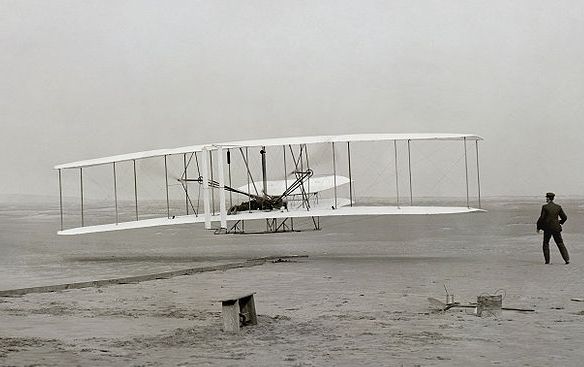Bikes and aircraft and composites go back a to the beginning. As a matter of fact, these all came together on December 17, 1903, when the first nonmetallic composite aircraft was flown by bike mechanics. Orville got the luck and glory of making the first flight. Wilbur also got to fly. What's less well known is that the composite got busted, putting an end to the day's shenanigans. It's been the same way ever since, though we have come far beyond the composite consisting of spruce and muslin.
Bike Mechanics Got Bored With Fixing Cranks and Experimented, Using Composites
in this Case, it was Spruce and Muslin Glued Together
it Broke, Establishing a Tradition that Lasts to this Very Day
First Flight of the First Composite Aircraft. Photo from the Library of Congress Collection
Starting with WWII, first the Forest Products Laboratory, and then what has become NASA, built on the start made by the Wright Brothers and those they followed. By the late 1960's, fiberglass with an epoxy matrix was common, and outfits like Grumman and McDonnell Douglas were using very strong, stiff fibers in it, such as Boron in the tail of the F-14 Fighter. Boron had the difficulty of being extremely difficult to work with and graphite or carbon (there's not really much difference) became the high tech fiber of choice by the mid 1970's. By the end of that decade, aircraft manufacturers were already contemplating their own holy grail of the "all composite" aircraft - effectively returning to their roots. I vividly recall the late 80's ,when we were looking at a carbon wing; perplexed by a military specification that said fuel tanks must be made from metal. Fortunately, the government clarified to say that just meant we couldn't use wood anymore. Carbon was OK. In the meantime, bike manufacturers had neglected their own heritage of leading the way in all things high tech, and were pretty much stuck on steel for the frames and aluminum for the rest of the bike components. I'll admit, I read Eugene Sloan, in his 1969 book, sneer at aluminum frames, and my own training did not kick in, even though I was already making stuff out of aluminum and carbon epoxy that could have brought 15 pound bikes to the market thirty years ago. Call this "the dark years for bikes." Ironically, some of the most elegant steel lugged bikes of all time came from this period. I guess you could also call them the "golden years." Still, bikes were getting left behind technologically. Thankfully, stupidity isn't a terminal condition.
America Drags Bikes Back Into the Game
Luckily, the American bike industry got really hammered by the Europeans, and then the Japanese. It left us in the same positions the Germans were after WWI. When you fall to the bottom of the pile, there's nowhere to go but up. In the words of Specialized, "Innovate or Die." Schwinn may have soldiered on with their really heavy euro wannabes - but they were a dead end and they eventually declared bankruptcy. The real innovation was left to the mountain bike movement - people like Ritchie & Fisher, and before you knew it, aluminum frames and carbon composites became part of the mix. Trek, Specialized, and Cannondale were never players when I was a kid, but thank goodness American innovation came to the fore. Raleigh and Peugeot and Cinelli were the peak when I grew up, but they were just making variations upon an old theme. The new American guys made their names and their reputations by not being restricted by the old European "Reynolds or Columbus tube and lug triangle" combo. While I LOVE steel and lugs, I also salute the determination to move beyond same. It's the same spirit that gave us the first aircraft. Bikes started to lead the way again. Before you knew it, carbon composites became part OF the bike game. Things came full circle.
Fads and Reality
Once the notion was accepted that advanced materials could move the bike world forward, manufacturers, in time honored tradition, carried things to ridiculous extremes. If you've read this blog closely, you've heard about carbon floor pumps and carbon rear racks. The problem, and that's what this series is really about, is to separate the hype from the places where carbon can really HELP the cyclist. My own concern is mainly about the transportation cyclist, but if that helps racers as well, that's not bad either.
I think there's little question that carbon CAN help people such as here and here. The question I'm interested in is whether it can help me on my ride to work. As we shall see, the answer is "yes, but one should not get silly over the stuff."











2 comments:
Make sure you include aerodynamics and the 12-16mph zone where aerodynamics and drag from aerodynamics begins to pick up. You build the bike for the intended purpose, but you also build the bike, especially if it's composite, to handle resistance from that against which you must push.
BTW- on sets of composite wheels, holding the exact same position, with equal temps, for two distinct 8k loops out at Texas Motor Speedway yesterday, at exactly the same average wattage for both runs, the Nimble Crosswind wheels required 3.95% less energy, and saved me about 40 seconds. Carbon fiber truly IS a great material.
One last thing - there is a GREAT review of CF and composites in this month's "Mountain Bike" Magazine.
I had a customer ask me for a Gore Tex pack cover when I worked in a mountaineering store in the 1980s. What in his backpack needed to breathe? But he needed the magic G-material! To his credit, he abandoned the notion when I suggested, with rare tact, that he could spend his money more wisely, even if he DID find a Gore Tex pack cover somewhere.
Fad materials are a wonderful thing.
Post a Comment
No Need for Non-Robot proof here!